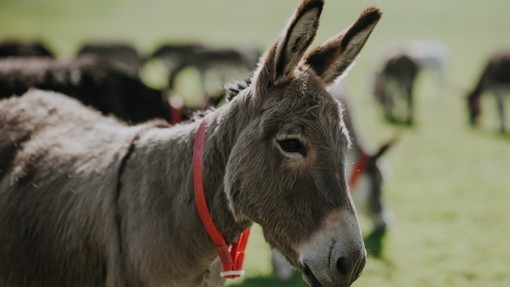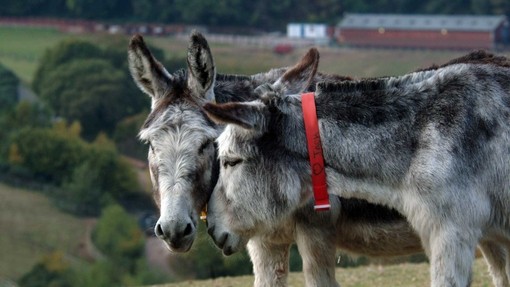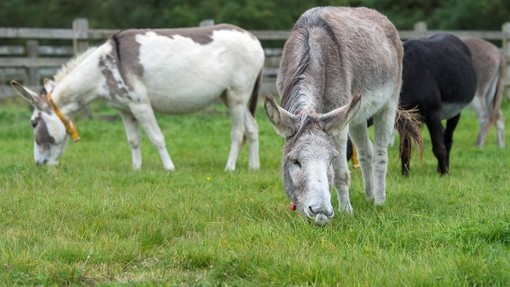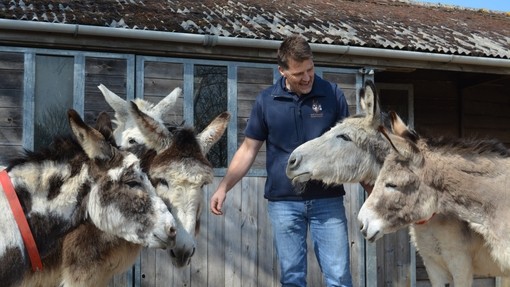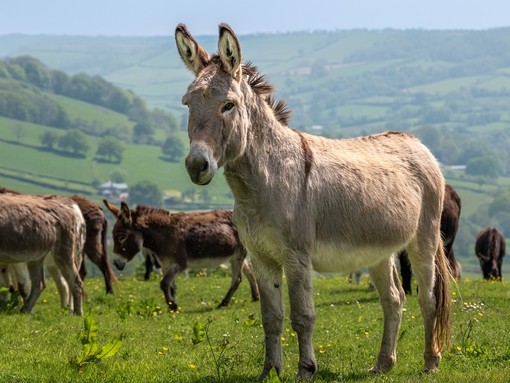
What are the different donkey breeds?
Miniature donkeys
Miniature Mediterranean donkeys, more commonly known as miniature donkeys, are a separate breed in their own right, originally hailing from the islands of Sardinia and Sicily.
Donkeys arrive here at The Donkey Sanctuary in all shapes and sizes, but one particular requirement of this breed standard is that the miniature Mediterranean donkey must reach no more than 91 cm at the withers (the ridge between the shoulder blades, the tallest point of the body).
These slight but attractive donkeys can be found in a wide variety of colours and markings, including chestnut, spotted, skewbald, cream, grey, brown and black.

The history of miniature donkeys
As outlined in our founder Dr Svendsen’s book, The Complete Book of the Donkey, these extremely small donkeys were originally used to turn grinding stones for grain inside peasants’ houses.
According to eighteenth century block pictures, the donkeys were blindfolded and attached to the grain mills and walked in endless circles. They were also used to carry water from village wells and supplies into the mountains for shepherds.
In more recent times they have become increasingly popular as pets, predominantly in North America, where there are a great many specialised breeders.
Did you know?
In 2014, we welcomed the arrival of Charlie, the smallest miniature foal to be born into our care.
Weighing just 14 kg and standing at knee height, young Charlie - nicknamed Dinky the Donkey - made national headlines after he was given sanctuary for life with his Miniature mother Summer, who was already pregnant when she was relinquished to the charity.
Where can I buy a miniature donkey?
Miniature donkeys have become popular has pets in recent years, particularly in the United States where these small donkeys are seen as cute companions.
The Donkey Sanctuary does not sell miniature donkeys. It is a big responsibility to care for a donkey, big or small. Rather than buying donkeys, we would encourage you to take a look at our rehoming scheme, giving a donkey a forever home, or if you don’t have the space you can support our care of miniature donkeys by adopting one of our two miniature adoption donkeys, Peanut and Maverick.
Poitou donkeys
The Poitou donkey breed originates from the Poitou region of France, about 300 miles south-west of Paris, and has a thick, matted and tangled coat.
The adult male Poitou is called a baudet (pronounced ‘bo-day’) and stands at 142-152 cm, while the Poitou mare is called an ânesse and is about one hand lower.

The history of Poitou donkeys
For hundreds of years the Poitou was bred solely to be used in mule breeding, an activity that made an important contribution to the French agricultural economy and earned the Poitou a worldwide reputation. The Poitou was exported to many countries, including America, Russia, the Belgian Congo and North Africa, and the army bought large numbers of mules.
By 1950 there was little demand for the Poitou, either in France or abroad. The mule could not compete with the tractor and the lorry, and mule breeding stopped providing a living for the breeder. The effect on the Poitou was catastrophic. Some breeders sold or killed their herds. There was little point in registering the birth of foals or the fact that animals had been sold. The Poitou donkey had become an endangered species.
In 1977 results of research into the breeding of the Poitou donkey were published. The statistics revealed that in the old province of Poitou, the recorded number of baudets (stallions) between 1949-1977 had fallen from 218 to 12 and the number of ânesses (mares) had fallen from 340 to 13. During the same period, the number of studbook registrations had dropped from 125 to 7. There was also concern regarding fertility as in 73% of recorded services, the ânesse either did not hold or aborted, and of the foals which were born, one third were dead.
SABAUD - Save the baudet
With fewer animals surviving, the problems of the breed became more acute. A programme to save the breed from extinction was agreed between the regional Parc Naturel, breeders, national studs, research scientists and local authorities. A census was taken of all Poitou donkeys and a studbook was opened with sections for pure-breds and part-breds. An experimental breeding unit was set up to improve the breed and breeding methods, and it was agreed to trace and preserve the old archives and to attract public attention and support.
Our involvement
The plight of the Poitou was brought to our attention and in 1986 we joined la SABAUD to save the Poitou donkey. The sanctuary’s help included research into genetic blood grouping of all known Poitou donkeys, artificial insemination and advice and help to the French breeders on modern techniques and stable management. The first step was to identify each donkey by electronic marking, which we funded. A team visited studs and advised on health care and general management. Dr Svendsen, Founder of the sanctuary, attended and judged one of the annual Poitou shows.
In 1988 our sister charity (now merged into The Donkey Sanctuary), the Elisabeth Svendsen Trust for Children and Donkeys (EST), brought three pure-bred Poitous to England so that they could be closely observed - a three year old male called Torrent and two ânesses called Jonquille and Amanda.
Our Poitou group
Since 1988 two pure-breds have been born at the sanctuary, Danielle and Iolanthe, and 15 part-bred Poitous. It was hoped that, due to their size and strength, they would be able to give rides to larger and older children at the EST centre here at Sidmouth. However, the Trustees of EST requested a trial by vets at a local college, and their report was definite in that they felt the bone structure of the donkeys’ legs were not strong enough to cope with working as we had planned. It also appears that Poitou donkeys are prone to congenital weakness of the spine and hips. As the donkeys proved unsuitable for EST’s purpose, they were given to the sanctuary where they will remain for the rest of their natural lives.
We also have two males and one female part-bred Poitou donkeys that were relinquished to the Sanctuary, as sadly their owner was moving abroad.
However, as the Sanctuary has a no breeding policy, no more breeding will be undertaken.
The future
A census of the pure-bred Poitou donkey population that had been scattered throughout Europe was carried out between 1992-1994. A committee of representatives of the National Studs, la SABAUD, the Breeders Union Stud Book and Park Naturel took this census. It showed that the young and growing population of pure-bred Poitou’s was three times greater than that of 15 years earlier. In 1995 there were over 200 Poitou donkeys. The gender ratio of the breed was equal.
Only 20 years ago the Poitou donkey faced extinction. Thanks to the resolve of local and national associations to meet this challenge, to support received from other regions in France and from abroad, and finally to the policy of la SABAUD and the dedication of its officers, this ancient breed has been saved.
Adoption donkey Percy and his fellow Poitou donkey friend Champagne can be seen here at the sanctuary and on our Shelter 6 webcam all year round.
Grand Noir du Berry donkey
The Grand Noir du Berry donkey breed of donkey comes from the Berry region of France and the height of a male ranges from 135-145 cm with the height of the female from 130 cm.
As with all Grand Noir du Berry donkeys, the cross is absent and there are no visible stripes on the leg. Their muzzles, underbelly and inside their forearms and thighs are white/grey as well as around their eyes. This breed of donkey can have a bay brown, dark bay brown or black coat.
The Grand Noir du Berry was the draught animal par excellence of the small farmer often seen working in fields and vineyards. Towards the middle of the 19th Century these donkeys replaced humans to pull the barges on the Berry canal and, further on towards Paris, on the Briare canal.
The Association Française de l’Ane Grand Noir du Berry was founded to promote the breeding and use of the Berry donkey and to establish a Stud Book. The census carried out in 1993 brought forth 80 donkeys (males and females) in conformity with the standard. In 2000, their numbers increased to nearly 600 donkeys.
Today, not only do these donkeys continue to work on small farms, their docile nature and strong physique lends them well to playing a part in tourism, carrying hikers’ luggage. They are also a highlight at many fairs and shows throughout France.
Mules and hinnies
Mules and hinnies are similar. They are both a cross between a horse and a donkey, with unique characteristics that make them special. Because they are so similar, the terms ‘mule’ and ‘hinny’ are used interchangeably, with hinnies often being referred to as mules.

What is the difference between a mule and a hinny?
A mule is a result of a donkey stallion mating with a female horse. Mules tend to have the head of a donkey and the extremities of a horse. Whereas a hinny result of a horse stallion mating with a female donkey. Hinnies are less common than mules and there might be subtle differences in appearance.
Caring for mules and hinnies
We have produced a resource with information on caring for mules and hinnies which details more about their characteristics and care needs.
Want to know more about donkeys?
Share this page
Tags
- Blog



